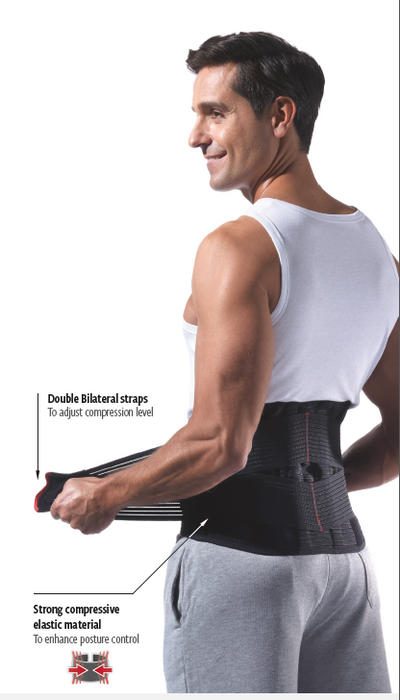An orthopedic doctor can prescribe a back brace for several conditions. Or, possibly you preferred to purchase a lower back brace to give lumbosacral support while lifting heavy boxes at work. Anyway, a back brace implies improving spinal health and decrease back pain and problems in the future. In addition, for many patients, a back brace provides a non-invasive solution to a painful back condition.
If your spine doctor has prescribed a back brace, also known as an orthotic, you may be questioning in your mind how it will influence your life. Well, the answer is it helps to manage a positive attitude and you should recognize that a brace is there to help you enjoy better health for a longer period. In addition, your doctor is there to answer any questions you may have and provide assistance throughout the process.
What is a back brace?
A back brace is a device that a person can wear to maintain their back. Some believe they can reduce back pain, promote recovery, prevent injuries, and promote accurate posture and proper spine alignment.
A back brace normally consists of an elastic compression band and rigid plastic or metal, or a mixture of both. It comes in custom-fitted or prefabricated designs. Prefabricated or "off-the-shelf" models are easily available and do not require fitting and molding.
When might a person need one?
A person may need a back brace for the subsequent reasons:
- Spinal stabilization after trauma or injury.
- For lifestyles or work activities that enhance the risk of back strain or injury.
- To improve posture problems.
A medical professional or doctor can recommend when it is safe or beneficial to use it.
How does Back Brace work to give support and aid posture?
The back supports the unloading of the load from the back and shifts it to the abdomen, decreasing the load on the spinal structures. Low pressure reduces muscle tension, a protective response to back injury and trauma, and the pain usually accompanies it.
Back braces also give proprioceptive input, helping people to improve their posture and use suitable body mechanics. One research recommends that wearing a brace for 3 weeks can enhance a person's proprioception, although this research was conducted over a period of 3 weeks, and the members did not feel back pain.
How to choose the type of Back Brace?
It is most satisfying to follow the advice of a doctor or physical therapist when selecting the style, material, and kind of back brace.
Level of support
Back braces can be rigid, flexible, or semi-rigid. The rigid type provides stability for people with conditions that cause moderate to severe pain and anxiety, like fractures or health problems after traumatic accidents.
Flexible types have more flexible materials to limit excessive movement and give compression while allowing more freedom and flexibility.
Semi-rigid braces consolidate the two and emphasize an adjustable brace for a body with rigid panels encircling the device.
Size and fit
Most off-the-shelf products appear in a universal size with flexible belt fins or hook and eye locks to secure a snug fit. Others are designed to be molded into a person's body.
Durability and maintenance
Machine washable braces are easy to manage. Braces with Velcro can wear out faster, while stretchy kinds can stretch after regular use.
Materials
Flexible braces often include cotton, neoprene, or canvas, while rigid varieties may involve metal, moldable plastic, or leather. Belts for sports lovers usually grasp heat to induce sweating.
Products
ProCare Clavicle Splint

This posture corrector aims to decrease chronic back pain by allowing a person to work for longer periods. It does this by adjusting the spike and reducing stress.
Features and specifications:
- provides support to the upper back
- machine washable
- fits chest sizes of 30–43 in
- offers basic support
DonJoy Back Brace ll - TLSO

This back brace restrains movement to help improve healing of the upper and lower spine. A doctor may prescribe this type of brace for patients with challenging conditions like burst fracture.
Features and specifications:
- provides support to the upper and lower back
- handwash only
- adjustable to 24–50 in and up to 70 in with extension panels
- offers maximum support
ProCare Universal Clavicle - Posture Brace

This posture corrector prevents shoulder, neck, and back pain by improving a person's posture as they do daily activities. A person can also adjust the shoulder straps to alter the tension. Additionally, the corrector enables height adjustment to accommodate diverse body shapes and sizes.
Features and specifications:
- machine washable
- fits chest sizes of 30–43 in
- provides support to the upper back
- offers basic support
DonJoy Actistrap

This economical lumbar back brace is strengthened with steel springs and features a dual-layer wrap-around design for the best support and stability. In addition, the detachable lumbar pad that appears with the brace proffers added compression.
Features and specifications:
- provides support to the lower back
- comes in sizes:
- Small (22–34 inches)
- Regular (28–50 in)
- Plus (50–70 in)
- offers maximum support
- machine washable
Conclusion
People with back pain may choose to utilize back braces or postural supports to decrease pain and correct their posture.
There are several back braces available across the counter. Though, people should consult a doctor to ensure that they choose a device that helps their condition.

